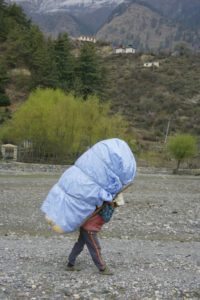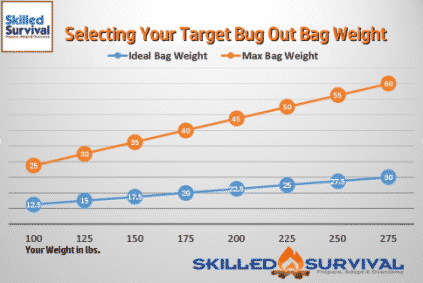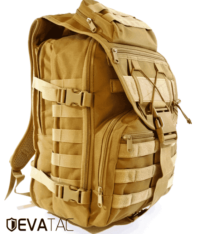
A Complete Guide To Reducing Your Bug Out Bag Weight
Do you know your exact pack weight?
Is it 15 lbs.? 20 lbs.? 37 lbs.? Not sure?
How far is your planned Bug Out?
5 miles? 11 miles? 23 miles? Just keep moving until you find somewhere safe…?
If your route takes you more than a couple miles then the weight of your Bug Out Bag matters…A Lot!
So lets figure out YOUR idea target weight and the best ways to shave out pounds…
TOPICS IN THIS GUIDE… ↓(click to jump)
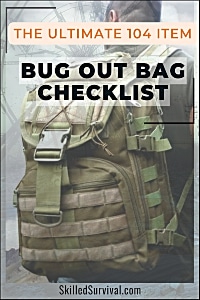
Want a free 104 item bug out bag checklist?
Click here to instantly download this Complete Checklist PDF. No purchase necessary.What A Bug Out Bag Is Really For?
The biggest opportunity for shaving weight off your Bug Out Bag is remembering what it’s for.
When planning your Bug Out Bag and its contents, it’s easy to forget its ultimate purpose.
It’s addicting put more and more items into your pack.
Adding everything you can think of for any possibility.
Do that…and you’ll end up with a back crippling 50 lbs. pack~
A Bug Out Bag should provide you with the bare essentials to survive for about 72 hours while on the move.
It’s should be designed to provide just enough stuff to survive a swift journey from point A to point B.
Allowing you to get the Hell Out Of Dodge.
Note: 72 hours is a very rough average; your Bug Out could be much shorter or longer depending upon your Survival Plan.

Want a free 104 item bug out bag checklist?
Click here to instantly download this Complete Checklist PDF. No purchase necessary.A pack of lightweight lifesaving supplies to help you arrive safely to your prearranged designation.
It’s vitally important to remember THIS fact…
You’ll be walking a long way with this thing on your back.
And A HEAVY PACK WILL SLOW YOU DOWN.
With a heavy pack, you will fatigue quickly, especially if you are not in peak physical condition.
Unless you’ve experienced backpacking for 3 days straight (and walked at least 8 miles each day)…you don’t understand the task you have ahead.
If your bug out bag is too heavy, you will quickly regret it.
You must decide what to keep and what to ditch.
And you must figure that out Right Now…Today.
NOT Mid Bug Out.
You need a Bug Out Bag that’s:
- Light
- Smartly Packed
- Ready To Go
It is not an option; it is a necessity.
You must keep this in mind at all times because you can’t carry everything…
Even if you’re building an INCH bag (I‘m. Never. Coming. Home.), you should still watch your overall pack weight.
The More Skills You Have…The Less Gear You Need
Before we get into some specific tips to help lighten your load…it’s best to determine if you need that gear in the first place.
For example:
Building shelters and fires allow you to leave heavy tents and stoves behind.
Leaving behind these two pieces of gear alone can shave up to 5 – 8 lbs.
Packing a large stash of food and water sounds great, but it’s ultimately of little use if you can’t carry it.
So instead, learn Water Procuring, Shelter Building, Fire-Starting, and Food Finding Skills without lots of “extra” gear.
Your Choice of Bag Matters
“30 lbs. in a poor fitting bug out bag sucks. 30 lbs. in an excellent fitting bag sucks much less.”
So let’s discuss your choice of bag for a moment.
When choosing your bug out bag pack, the most important factor is not your overall height but the length of your torso.
You must have a bag that fits you.
It must fit your torso comfortably and sit on your hips .
You should measure your torso with tailor’s tape (avoid guesswork here).
You want to measure from your hip to the bone at the base of your neck.
That’s the spot where your neck meets your shoulders.
This determines your torso length.
You also want to measure your hips.
Measure from hipbone to hipbone or from pocket to pocket (all the way around).
This is where the hip belt will rest.
Now utilize these 2 measurements (torso and around hips) to select a pack that fits.
Having your pack’s hip straps sitting too high or too low will affect the gait of your walk.
Remember, bugging out will likely consist of
- Hiking
- Running
- Scrambling
- Climbing
If you buy one online, try it on ASAP.
If it doesn’t fit right, return it ASAP.
This is not a purchase you can’t afford to accept wrong.
Bottom line:
Pack smart and light, and ensure your bag fits right.
My favorite bug out bag is The Combat Bag by EVAC.
You should check out my detailed video review of this excellent bag:
↓ Bug Out Bag Review – The Combat Bag by EVATAC

Want a free 104 item bug out bag checklist?
Click here to instantly download this Complete Checklist PDF. No purchase necessary.So How Much Should A Bug Out Bag Weigh?
“The target weight of your Bug Out Bag is determined by YOUR weight.”
The basic formula to remember when packing your Bug Out Bag is this:
Your ideal target weight is 10% of your body weight.
The maximum you should attempt to carry is %20.
For example, if you weigh 200 lbs., then 10% of 200 = 20 lbs.
If you aim for the 20% max, you must be in peak physical condition.
Otherwise, you will fatigue quickly, thus hampering your escape.
In this example, if you weigh 200 lbs., then 20% of 200 = 40 lbs.
You need to estimate realistically your target weight and what you can safely carry.
To help, I’ve compiled a simple chart for you to use as a guideline.
Find your weight in lbs. across the bottom.
Then find your recommended “ideal” and “maximum” Bug Out Bag Weight.
A Note Of Caution: These recommended weight ranges highly depends on your physical health and strength.
Now that we know how much a bug out bag should weigh, it’s time to figure out the best ways to make that happen:
↓ 10 Tips To Reduce Your Bug out Bag Weight
1. How Much Water Do We Really Need to Carry?
A liter of water is heavy.
It weighs about 2.2 lbs., so 3 liters of water equals 6.6 lbs.
6 lbs. may not sound like much, but when added to all your other gear, it’s a heavy problem.
You can carry very little H2O IF you know how to procure and purify it on the go.
However, this depends on your specific bug out region.
I personally plan only to carry about 1 liter of water at any given time.
If, like me, you don’t plan to haul 6 lbs. of water, you’ll need to prepare and plan.
You can either cache water along your route or find water and treat it on the go.
So if water is abundant, learn how to purify it.
If it is not, learn how to find it or cache it.
If you decide to cache water along your route, remember to mark your map where you cached it.
There’s nothing worse than searching for your water cache water and not being able to find it.
If you decide to procure water , then make certain you have some known reliable sources along the way.
There are several ways to purify water.
So practice one or two ways to purify water until you can turn nasty, stagnant water into safe drinking water.
This will allow you to leave most water out of your light bug out bag.
2. But What Will We Eat?
Now it’s time to review your bug out bag’s food stock.
Recall you can exist for about three weeks without food.
However, you are bugging out and need the energy to stay mentally alert.
So how are you going to reduce your food supply?
This is where your survival skills will really come into play.
When packing, use a Bug Out Bag Checklist, including one freeze-dried meal for each family member.
Plus, a few high-calorie energy bars.
This is one day’s worth of food.
This amount of food will allow you to survive your bug out.
No, it won’t keep the hunger away.
But it will provide enough energy to remain healthy and alert.
Now, the more skills you have, the more food you might acquire.
Now, with some additional skills, you can find some BONUS foods along the way.
If you break camp near a lake or river, you may be able to find fish to eat.
All you need is a bit of fishing line and a hook (both very light).
You can find a stick near the stream to tie the line onto.
Cast it in the water and wait for dinner.
Place the fish next to the fire with the skin left on to cook the fish; this removes the need for a cookstove, fuel, and pots and pans.
Bonus food may also be found in the woods.
If you know how to identify plant edibles or know how to use snares or traps, you might be able to find some more bonus food.
The snare and traps might work overnight to get a squirrel or two.
Again, having these skills means carrying less heavy food stock.
The more things you know how to do and make in the wild, the better.
One more trick to help lighten the food load fast is to eat your heaviest foods first.
Your legs are freshest on day one, but your pack is heaviest too.
Eating the heavier rations first will reduce your pack weight quickest for days 2 and 3.
This gives you the maximum caloric benefit and lessens the weight of your pack each day.
3. Ditch The Tent For A Tarp
Brush up on your survival skills and ditch the tent.
A tent with all its poles and stakes can add several unnecessary pounds to your growing pack.
So instead of carrying a tent, carry a survival tarp.
A light tarp (with lots of grommets) will suffice to create a simple shelter from most elements.
It can also be used as a blanket.
OR build a shelter with what’s available.
Pine trees with low-hanging branches are a relatively safe shelter from wind and rain.
They also have a layer of needles under them, which can provide you with a soft pallet to lie on.
Underneath these trees, the ground is usually soft enough to dig up the earth with a stick.
This allows you to make a shallow impression that you can line with pine needles to afford you some comfort and warmth.
Humans have used rock overhangs or shallow caves for thousands of years to survive.
Just ensure the area is empty of unwanted animal guests before committing to it for the night.
If these are not options for you, then you might be able to use some paracord and a tarp to create a simple lean-to shelter.
All you really need for most nights is protection from wind and rain.
Sure, it can be a bit frightening sleeping outdoors (without a tent) for the first time.
So I suggest you practice this in your own backyard.
And then practice this along with your bug out route as well.
You’ll soon get used to sleeping under the stars.
One downfall of building your own shelter is it takes time and burns precious calories.
By scouting your route carefully, you can mark on your map where you found food items, timber, water, and everything you need to survive.
With survival knowledge and practice, you should be able to craft a decent shelter to protect yourself from most weather.
I can hear some of you already….
But what if there is a Lightning Storm? Tornado? Forest Fire? Blizzard?
Yes, my friends, these are risks.
But how are these risks lessened by sleeping in a heavy-to-carry tent?
No, they are Not.
Those risks are an inherent part of wilderness survival.
Actually, it’s much better to hunker down in a shallow cave or overhang if a tornado roars by instead of a tent out in the open.
Now, if it’s winter when you are bugging out, the heavy snow around the base of a pine tree can form a sort of igloo.
This can provide protection and warmth for your family.

Want a free 104 item bug out bag checklist?
Click here to instantly download this Complete Checklist PDF. No purchase necessary.4. Sleeping Bags Are Overrated
Another place to save on your “go bag” weight is to ditch your sleeping bag.
You will not need a sleeping bag if you’re bugging out in the summer.
You can use your tarp, which weighs much less.
If you’re worried about being warm, add a light liner, which will be fine for warmer temperatures.
You can trim weight using a bivy sack if you are in mountainous terrain or frigid winter temperatures.
It’s made from the same stuff as the Emergency Blanket that EMS attendants use for hypothermia victims.
A bivy bag has been made to cover the body from head to toe.
Additionally, it helps trap your body heat.
Using both the bivy bag and the Blanket will still shave a few pounds off your light Bug Out Bag.
It also acts as a windbreak against cold, rain, snow, and wind.
Stretched out, the TACT Bivvy is 7 feet long and 3 feet wide.
Once it’s rolled up, it shrinks so small that it fits in the palm of your hand and weighs only 6.2 ounces.
It is much less bulky and lighter than carrying a traditional sleeping bag.
↓ Survival Frog TACT Bivvy Review
5. Are Your Extra Clothes Holding You Back?
Your clothes selection is dependent upon your location and climate.
You should re-evaluate your Bug Out Bag clothes stock at least every six months (I do it at the beginning of each new season).
During these times, you will want to ensure you have the right seasonal selection of clothes to swap out when needed.
Also, investing in durable, high-quality clothes (like tactical pants) instead of carrying lots of extra low-quality spares.
Another way to save some weight and space is to roll your change of clothes into a skivvy roll.
What is a skivvy roll, and what goes into it?
A skivvy roll is a couple of basic spare clothes items that you roll into a small tight ball.
First, to save space and weight, the only pair of pants you need are the ones you wear.
After that, you need a change of socks, underwear, and a shirt.
So that’s what you put in your skivvy roll.
Lay your t-shirt flat and place your underwear folded in half in the middle of the shirt, right below the neckline.
This makes it easier to roll.
Fold the right side of your shirt to the middle, and then do the same with the left side.
Take a pair of crew socks; anything larger or smaller will not work quite as well; cross them toe to heel over the sleeves of your folded shirt.
Once the socks are in place, begin rolling from the collar down the shirt to the bottom.
The tighter you roll, the less space you will take up.
When you are done rolling, you should have two ends of the socks sticking out on either side.
Take one end and fold it over the roll. Then take the remaining sock end and fold it over.
This is your Skivvy roll.
A family of four with clothes rolled in a skivvy roll will barely weigh one pound.
Here’s a quick video by a fellow survivalist, “The Sensible Prepper,” making a skivvy roll.
↓ Bug Out Bag Skivvy Roll
6. Leave Your Camping Lanterns Behind
Don’t take a heavy camping lantern.
A good EDC flashlight is enough.
And fit in your pocket so you can leave the camping lanterns behind.
Want a free FireHawk Tactical Flashlight?
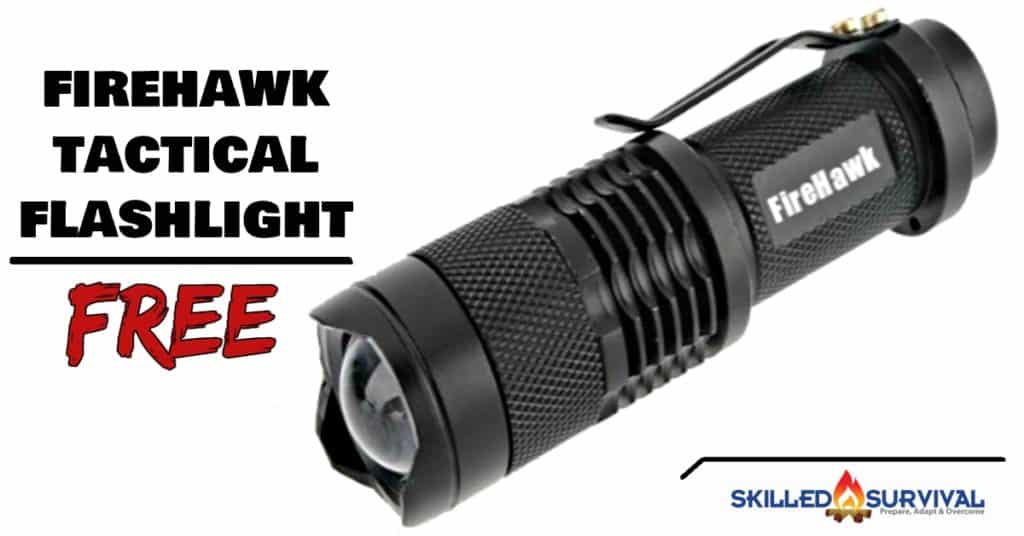 Click here now to access this limited time offer, just cover the small shipping & handling fee.
Click here now to access this limited time offer, just cover the small shipping & handling fee.
At night, you can also use the light from your fire.
Some people advocate ditching everything unnecessary, and I typically support this notion…
Except for fire starters.
Carry at least 3 different types of fire starters.
A lighter, waterproof match and a Ferro rod.
These are small and lightweight, and the ability to create fire quickly.
You also don’t want to waste your precious energy and calories trying to start a fire with sticks (although it’s an excellent skill to have).
Without fire-starting gear, you could be in for a long, cold, miserable, and dangerous time.
Survival is dependent upon taking advantage of given opportunities.
Note: if you walk through an area littered with kindling, you should take a little with you.
You never know if there will be any kindling at the next stop.

Want a free 104 item bug out bag checklist?
Click here to instantly download this Complete Checklist PDF. No purchase necessary.7. Firearms: Keep It Light
I think hunting gear is too heavy to justify a bug out.
Recall, the point of a bug out is to get from point A to point B as expeditiously as possible.
Hunting takes time and attention away from what’s really important, which is moving quickly.
It doesn’t make much sense to carry around 10-20 pounds of firearm gear on the off chance of taking a shot at something.
However, I do keep a loaded pistol with me for self-defense.
When it’s “go-time,” things won’t be pretty.
It’s possible that the civil order has broken down and been replaced by survival of the fittest.
I don’t intend to be a poor bastard who left his gun behind…just in case.
8. Cache “Extra” Ammo Along The Way

Carrying enough ammo to take a village by force is another.
The less ammo you carry means traveling faster and reaching safety sooner.
Deciding how much ammo you should carry is a very personal choice.
However, next to water, any extra ammunition you carry will be the most cumbersome gear in your pack.
I suggest you cache some ammo along your route.
That way, you can decide to add that ammo to your pack along the way (if needed) or leave it behind.
9. Packing Right Makes It Feel Light
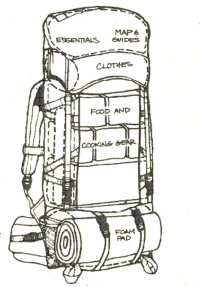
The further away something is from the fulcrum, the more it pulls.
In Engineering and Physics it’s called a Moment Force.
Putting the heaviest things close to your body reduces undue stress.
You don’t want to hang a bunch of water and ammo to the outside of your light bug out bag (furthest away from your body).
As an example of this principle, try carrying something heavy with your arms fully extended out in front of you.
Not easy or comfortable.
Instead, you’d rather bring that heavy object in close to your body (hugging the object) since this is much easier to carry.
Having the heavy items further out in the pack makes it harder on your shoulders and back to carry.
Also, pack the stuff you don’t need as frequently on the bottom and the items you will reach for often at the top.
This allows you to find items quickly.
Another way to cut pack weight and still keep what you need is to put it in your pockets.
You are still carrying the weight, but moving it out of your pack and onto you, will reduce the stress your back takes.
Also, remember dual-use items take up less space and weigh less for the same amount of utility.
Often survival is about creativity.
Being creative will help you survive.

Want a free 104 item bug out bag checklist?
Click here to instantly download this Complete Checklist PDF. No purchase necessary.10. Go Hard Core
So you’ve trimmed your pack weight significantly by following the previous 9 suggestions, but you know you can still do more.
Well, you are right…
And these 10 hardcore tips are the little, unknown, meticulous fractions of ounces that you can attempt to trim (if you’re HARDCORE).
None of these tips by themselves will make a noticeable impact.
But all together, they’ll add up and reduce your overall bug out bag weight.
- Cut Off Any/All Extra Straps, Zipper Tags, or Fabric Not Needed On Your Bag
- Remove Any Labels or Stickers From Both the Bag and Gear
- Trim Unnecessary Edges Off Of Your Map
Replace your Spoon and Fork With A Titanium Spork
- Saw Off The Handle Of Your Toothbrush
- Replace Toothpaste With Toothpowder
- Transfer Any Liquids (sunscreens, soap, etc.) Into 1 oz. Bottles
- Use Ziploc baggies (very light) Instead Of Sacks To Keep Items Together
- Buy Titanium Gear When Possible
- Drill Holes In Everything You Can (Utensil Handles / Toothbrushes / etc.)
To Go Ultralight, You Need To Practice, Practice, Practice…
Now, let’s return to the Survival Skills conversation we started earlier.
I have a simple question for you, and you must be prepared to answer it without hesitation…ready?
“If you ditch your tent, stove, extra water and extra food are you prepared to survive without them?”
Are you 100% confident in your survival skills?
I’m talking about actually performing a practice bug out with limited supplies.
You don’t want to assume you can do it when your and your family’s lives are in danger.
It’s a high priority to understand how vital your mental state is during a survival encounter.
A person’s mindset during a survival conflict can decide whether you endure the situation or give up and die.
So while you are out practicing your bug out, take some time to look at every different natural formation and ask yourself how it can be used to build a shelter.
Building a shelter for yourself and your family protects them from adverse weather and gives you a mental boost.
A shelter is mentally akin to fire; they both give us hope and a sense of achievement.
When immediate shelter needs to be found, crawl under a spruce tree, or find some form of natural cover.
These will allow you to block the wind and begin conserving warmth.
Unless you hike often, you probably are unaware of how quickly a lovely warm day can deteriorate into dangerous weather.
Keep in mind when the temperature drops due to wind and rain.
A seventy-degree day can quickly become a forty-degree day, which can quickly cause hypothermia.
Under certain conditions finding proper shelter and warmth can make the difference between life and death.
When you begin to lose body heat, your movements become impaired as hypothermia begins to set in.
Imagine trying to light a fire while with a Ferro rod while you begin losing motor function in your fingers…it’s not pretty.
You must be fully prepared to adapt to any situation and protect your family without “extra” heavy gear.
If you practice while your life is not in danger, your reflexes will kick in when it is in danger.
You will learn exactly what to do.
Knowing the natural resources available in your area or along your route will also help build confidence in your survival skills.

Want a free 104 item bug out bag checklist?
Click here to instantly download this Complete Checklist PDF. No purchase necessary.Final Thoughts
If you’re serious about bugging out; you should care about your bug out bag weight.
The best way to lighten your load is to leave the unnecessary equipment out.
You can do this by using survival skills or caching key items along the route.
Or even better…do both.
However, both of these choices require pre-planning and practice.
So, if you plan and practice, then you will KNOW that you can handle your bag weight and have everything you need for a quick and successful bug out.
Sadly, some will bug out with an extremely heavy pack AND no practical survival skills.
Those people will be putting themselves and their families in extreme danger.
A heavy pack will slow them down and fatigue them.
They will be forced to ditch items mid-bug out to “make it.”
Then they will be left without items they are unprepared to survive without.
Why Trust Skilled Survival...
Go here now to review a full breakdown of:
- Who We Are
- Our Credentials
- Our Mission
- & Product Recommendations...
Here are a few highlights of our teams credentials & certifications:
- Certified Member of a Mountain Search & Rescue Organization
- Plant Emergency & Safety Leader for a Major Food Manufacturer
- Member of the 10TH Mountain Division Hut Association
- Certifications: Avalanche 1, WFR, CPR
- Official Gear Tester for Numerous Outdoor Gear Companies
- Countless Multiday Backpacking trips into Remote Wilderness
- Bachelor's Degree In Mechanical Engineering
- Bachelor's Degree In Civil Engineering
- Bachelor's Degree In Biomedical Engineering
"It takes 20 years to build a reputation and five minutes to ruin it." - Warren Buffett
We're fully aware that trust is NOT something you GET but is EARNED.
And we'll continue to earn YOUR trust through our forthright and honest approach with each new Blog Post, Guide & Product we create...
Prepare, Adapt & Overcome,

P.s. Do You Live In A 'Danger Zone' County?

Find out now using my Danger Zone County List & Special Report it’s absolutely FREE.
In minutes you’ll know EXACTLY where you stand and if you should be worried or not..
So click here to get my FREE Danger Zone County List & Report…

Recommended Reading
Best Bug Out Bags: The Most Reliable Pack Experts Trust
You deserve a bug out bag you can trust; a pack to protect all your gear. Here's how to find a good one and avoid making amateur mistakes.
Bug Out Location: Finding A Perfect One You Can Afford
There are 7 must-have qualities for a perfect bug out location . I show exactly what they are and how to find an affordable one in minutes...
Bug Out Vehicles: The Best Setups To Escape The Chaos
A good bug out vehicle will help you make it out of chao to safety FAST. I show you the best options and capabilities to design your own rig.
Bug In Vs Bug Out? Smart Or Guaranteed Death Trap
One of the hardest SHTF decisions is: Bug In vs Bug Out. You should plan for both because there some situations where you may have to leave.
Bug Out Bikes: The Most Reliable Way To Escape Chaos
A simple 6 step action plan to turn a regular bike into a badass, terrain crushing bug out bike - to escape the chaos without traffic jams.
Best Survival Retreat: How To Secure Your Own Safe Haven
Building your own survival retreat is easier and more affordable than you think. Log cabins, dug outs, adobe huts are all great options.
